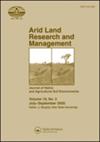土壤盐分空间变异的来源:以摩洛哥塔德拉平原贝尼阿米尔灌溉指挥区为例
IF 1.6
4区 农林科学
Q3 ENVIRONMENTAL SCIENCES
引用次数: 5
摘要
灌区盐分的来源和空间变异性是制约农田长期管理的重要因素。据报道,在摩洛哥的一个主要产区塔德拉平原出现了地下水资源的区域枯竭以及土壤盐碱化。在西北地区,供水仅由当地地下水位提供,并分析了近24年来地下水位和盐度的演变。经盐度校正(r2 = 0.94)后,电磁感应(ECa)对17个样地进行制图。这些地块种植不同的作物(小麦、橄榄、甜菜、苜蓿、胡萝卜),很少或不轮作,或休耕。结果突出了盐渍化的两个主要因素。一方面,作物的类型导致盐碱化,根据水的需求而增加,这很少得到满足,因此有利于盐在土壤剖面的上部积累。第一个因素解释了80 - 85%的ECa测量差异。另一方面,与大量泄漏相关的重力灌溉方法导致地块内的水分布不均匀,与方差的15-20%相关。这些结果证实了目前对这一水力文化系统的不可持续的管理,并强调需要更好地获得优质水和改进灌溉技术。简要介绍了一项发展建议。本文章由计算机程序翻译,如有差异,请以英文原文为准。
Sources of spatial variability of soil salinity: the case of Beni Amir irrigated command areas in the Tadla Plain, Morocco
Abstract The origins and spatial variability of salinity within irrigated plots are a constraint to good long-term field management. Regional depletion of groundwater resources, as well as soil salinization, have been reported in the Tadla plain, a key production area in Morocco. In the northwestern part, water supply is provided only by the local water table, whose evolution in level and salinity over the last 24 years has been analyzed. A mapping of 17 plots was carried out by electromagnetic induction (ECa) after calibration of the measurements with salinity (R 2 = 0.94). These plots are cultivated with different crops (wheat, olive, sugar beet, alfalfa, carrots) with little or no crop rotation, or left fallow. The results highlight two main factors of salinization. On the one hand, the type of crop leads to salinization that increases according to water needs, which are rarely satisfied, thus favoring the accumulation of salts in the upper part of the soil profile. This first factor explained 80 to 85% of the variance in ECa measurements. On the other hand, the gravity irrigation method associated with numerous leaks is responsible for an unequal distribution of water within the plots, associated with 15–20% of the variance. These results confirm the current unsustainable management of this hydro cultural system and highlight the need for better access to quality water and improved irrigation technology. A development proposal is briefly presented.
求助全文
通过发布文献求助,成功后即可免费获取论文全文。
去求助
来源期刊

Arid Land Research and Management
环境科学-环境科学
CiteScore
3.80
自引率
7.10%
发文量
23
审稿时长
9 months
期刊介绍:
Arid Land Research and Management, a cooperating journal of the International Union of Soil Sciences , is a common outlet and a valuable source of information for fundamental and applied research on soils affected by aridity. This journal covers land ecology, including flora and fauna, as well as soil chemistry, biology, physics, and other edaphic aspects. The journal emphasizes recovery of degraded lands and practical, appropriate uses of soils. Reports of biotechnological applications to land use and recovery are included. Full papers and short notes, as well as review articles and book and meeting reviews are published.
 求助内容:
求助内容: 应助结果提醒方式:
应助结果提醒方式:


